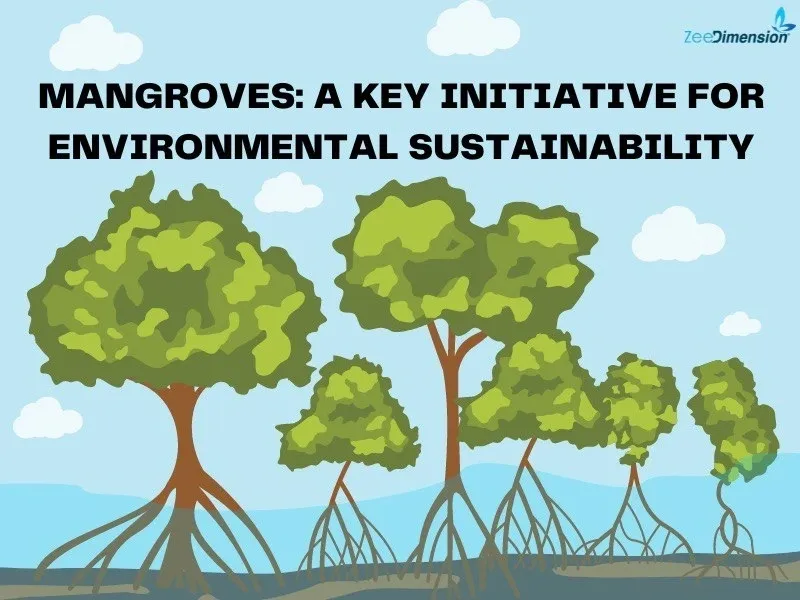
Mangroves are becoming more widely acknowledged as essential to the global movement toward environmental sustainability. These distinctive coastal forests, which are found in tropical and subtropical areas, are critical to the fight against climate change because of their capacity to store vast amounts of carbon. Mangroves offer vital ecosystem services such as preventing erosion along coastlines, promoting biodiversity, enhancing water quality, and their ability to store carbon. The restoration and preservation of mangrove ecosystems have emerged as a critical endeavor in response to mounting environmental pressures, providing a natural solution for advancing resilient development and climate change adaptation. Let’s explore how this contributes to carbon sequestration and environmental protection.
What is the Mangroves?
Mangroves are a kind of tree or shrub that grows well in the coastal intertidal zones, which are areas where freshwater from rivers and saltwater from the ocean meet. These unusual plants are widely found in tropical and subtropical regions of the world and are adapted to grow in brackish water. To provide stability in soft, wet soils, mangroves have unique roots that either grow horizontally or rise above the water. They can filter salt from seawater and anchor themselves in tidal areas that are prone to flooding and high salinity thanks to their roots, which are essential for their survival in salty and oxygen-poor environments. In addition to protecting shorelines, mangroves are extremely productive ecosystems that serve as homes for a variety of marine and terrestrial species.
What are mangroves and why are they important?
Mangroves are tropical and subtropical trees and shrubs found in coastal intertidal zones. They thrive in harsh conditions like low-oxygen soils, fluctuating tides, and salty water. Their distinctive root systems stabilize soil, prevent erosion, filter pollutants, and absorb oxygen in wet conditions, making them essential for plant survival. Mangroves are crucial for coastal defense, carbon sequestration, and habitats for diverse species. They protect shorelines from storm surges, tsunamis, and erosion, and capture large amounts of carbon dioxide. Mangroves also improve water quality by filtering out pollutants and enhancing marine ecosystems like coral reefs and seagrass beds. They also support livelihoods by providing resources like fish, wood, and eco-tourism opportunities.
Why are mangroves considered essential for coastal ecosystems?
Mangroves are crucial for coastal ecosystems due to their complex root systems that stabilize shorelines, prevent erosion, trap sediments, and reduce wave and storm impacts, providing protection against storm surges, hurricanes, and rising sea levels. Mangroves are essential for coastal ecosystems due to the following reasons:
-
Shoreline Stabilization: By capturing silt, their root systems lessen coastal erosion and shield shorelines from high tides and storm surges.
-
Natural Coastal Defense: Mangroves absorb wave energy and lessen damage to coastal areas, acting as storm, hurricane, and tsunami buffers.
-
Biodiversity Support: They support rich biodiversity by offering fish, crustaceans, birds, and other wildlife vital habitats and nidification grounds.
-
Water Filtration: Mangroves improve water quality and protect ecosystems like coral reefs by filtering out pollutants, excess nutrients, and sediments from coastal waters.
-
Carbon Sequestration: Mangroves effectively capture and store carbon, serving as significant carbon sinks to mitigate climate change.
-
Support for Local Livelihoods: They improve the local economies of coastal communities by offering resources like food, wood, and tourism opportunities.
Mangroves are essential to the sustainability and well-being of coastal ecosystems because of each of these reasons.
What are 5 Scenarios highlighting the importance of mangroves?
📷
Scenario 1
Company Plants 1,000 Mangrove Trees
Total carbon absorption per year: 1,000 trees x 0.30 tonnes/tree = 300 tonnes of CO2/year
In just one year, this company can remove 300 tonnes of CO2 from the atmosphere.
-
Over 10 years: 300 tonnes/year x 10 years = 3,000 tonnes of CO2 removed
-
This long-term effort shows how impactful mangroves can be in mitigating climate change.
Scenario 2
Global Effort: 1 Million Mangroves
If organizations plant 1 million mangroves: Total carbon absorption per year: 1,000,000 trees x 0.30 tonnes/tree = 300,000 tonnes of CO2/year
-
Over 10 years: 3,000,000 tonnes of CO2 removed.
Long-Term Sustainability
Mangroves continue to absorb carbon as they grow.
For companies, mangrove planting is not just an immediate action—it’s a long-term investment in environmental resilience.
Scenario 3
20-Year Impact of 1,000 Mangroves
Total carbon absorption over 20 years: 300 tonnes/year x 20 years = 6,000 tonnes of CO2 removed
Mangroves are a sustainable, long-term solution for carbon reduction.
Additional Benefits of Mangroves
-
Coastal Protection: Mangroves protect shorelines from erosion and storm surges.
-
Biodiversity: Mangroves provide safe habitats for marine life, enhancing biodiversity.
Scenario 4
Preventing Coastal Erosion
A coastal community plants 5,000 mangroves: The trees absorb 1,500 tonnes of CO2 annually while protecting the land from natural disasters.
Supporting ESG Objectives
Mangrove planting helps companies:
-
Reduce carbon footprint
-
Strengthen community ties
-
Enhance ESG reputation
Scenario 5
Offsetting CO2 Emissions through Mangroves
A company emits 10,000 tonnes of CO2 annually and aims to offset 50%. By planting 16,667 mangroves, they can achieve a 50% reduction in emissions.
Long-Term Benefits
-
Mangrove planting is a sustainable way for companies to meet environmental goals and protect ecosystems for future generations.
Conclusion
In especially in coastal areas, mangroves act as an essential buffer against the effects of climate change. In addition to stabilizing shorelines, their extensive root systems lessen the effects of storm intensity and sea level rise, both of which are direct results of climate change. Mangroves protect coastal communities and infrastructure by absorbing wave energy and reducing erosion, which lowers the costs of disaster recovery and infrastructure repair.
Companies can demonstrate sustainability by promoting mangrove restoration and conservation initiatives, which not only enhance environmental stewardship but also contribute to their corporate social responsibility goals. These initiatives can involve direct funding for restoration projects and collaboration with local communities and environmental organizations.







